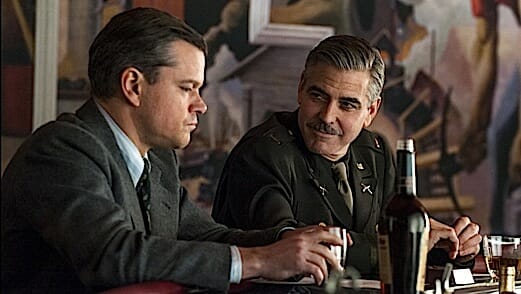The Monuments Men

Directed and co-written by George Clooney, The Monuments Men boasts a premise, cast and production values well deserving of the initial buzz it gathered. The production calculus of the film seems pretty sound: tell one of last great untold (to the masses, anyway) true stories of World War II—one in which “the good guys” occupy a true, unassailable moral and aesthetic high ground from start to finish. Widen the demographic appeal by bringing together an ensemble of actors whose “likability” quotient is through the roof. Finally, graft the plot arc all onto a template established by a markedly less uplifting World War II film. (Critic Ty Burr’s reference to the plot as being “half Saving Private Rembrandt” is dead on.) Hm, well, maybe that last part sounds a little shaky, but the rest of it should work, right?
Only it doesn’t. Instead, tonal instability trumps all, yielding a film that fascinates more in the post-mortem pondering than via cinematic punch. At times, The Monuments Men seems pulled in opposing directions by the attempt to both be true to the story while also giving the audience the more conventional plot arc it (arguably) needs. Such custody battles seldom end well.
If it weren’t based on the real-life efforts of the more than 400 men and women involved in the Monuments, Fine Arts, and Archives program during the final years of the war, Clooney’s film could be viewed as a rare instance of art historian propaganda. (A cinematically unexciting profession hasn’t been this transformed on screen since Prof. Jones miscalculated the amount of sand needed to replace a gold idol on a trapped pedestal.) But in truth, the program helped find and preserve millions of cultural treasures stolen by the Nazis or otherwise threatened by the ravages of war. The staggering scope of the effort carries with it some inherent dramatic hurdles, though, the first of which is the need to distill this far-reaching effort involving hundreds of people into a feature-friendly cast of no-more-than-ten. In attempting to clear this, the casting provides as much lift as possible.
-

-

-

-

-

-

-

-

-

-

-

-

-

-

-

-

-

-

-

-

-

-

-

-

-

-

-

-

-

-

-

-

-

-

-

-

-

-

-

-








































